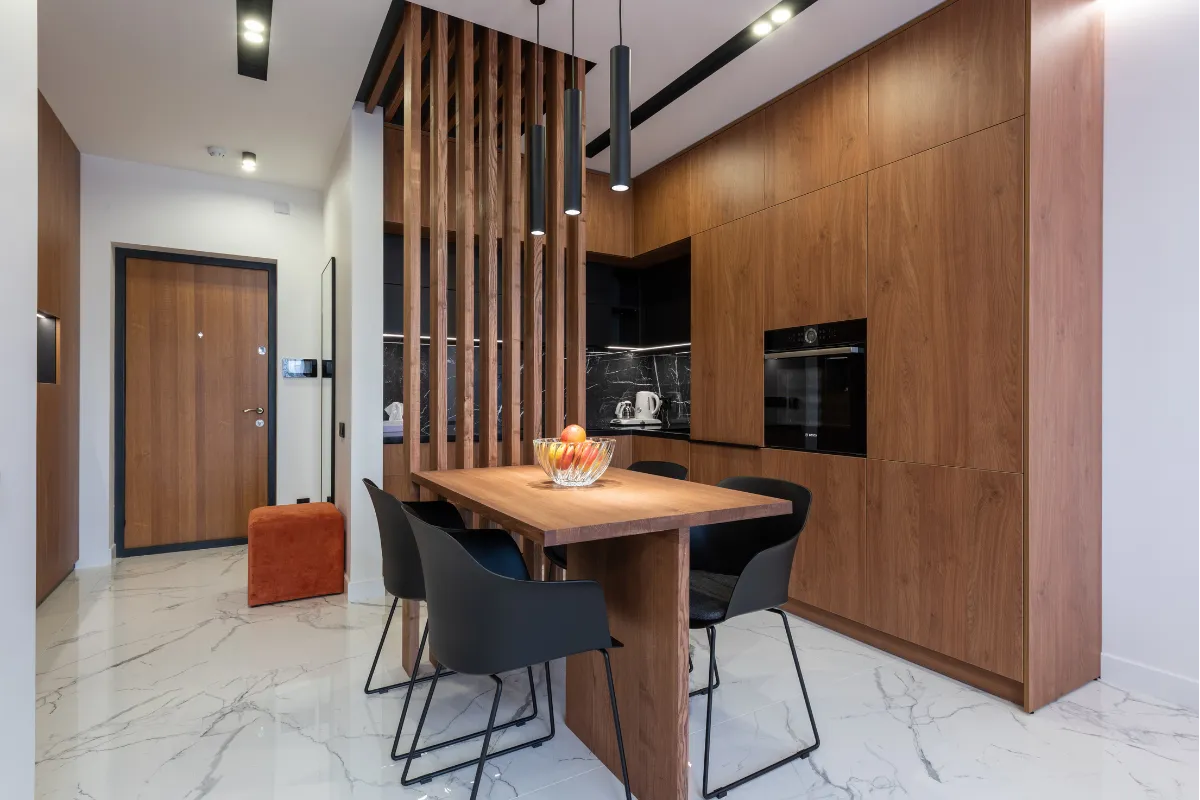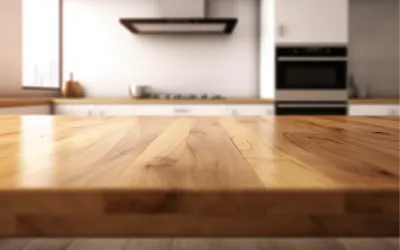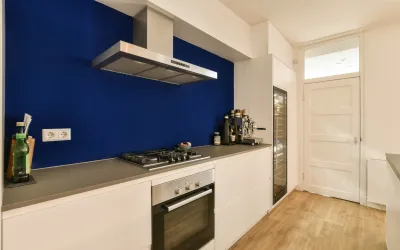The appeal of wooden furniture in home décor is timeless. It’s not just furniture but a piece of art that embodies elegance, strength, and the raw beauty of nature. However, the type of wood you select—be it hardwood like cherry or maple wood or perhaps engineered wood for more practical applications—plays a crucial role in bringing your interior vision to life.
Knowing which wood for furniture to choose can significantly impact the longevity and beauty of your wooden furniture. In addition, the specific wood type can affect the environmental impact of the furniture. Hence, making an informed choice is very important.
So, how do you find the real wood that perfectly matches your décor dreams and practical needs?
The Types of Wood in Furniture Making
Hardwoods vs. Softwoods: What’s the Difference?
The primary distinction in the wood type used for furniture—namely hardwood and softwood—lies in the source trees. Hardwoods, derived from deciduous trees, are generally denser and more durable, making them ideal for pieces like dining tables and other furniture that demand longevity. Softwoods from coniferous trees are lighter and offer versatility for indoor and outdoor furniture.
Popular Hardwoods
- Oak: A durable and often used type of wood in furniture making, oak boasts a distinct wood grain that adds depth to furniture pieces. Its strength is ideal for heavy-use items like dining tables and rustic furniture.
- Mahogany: Known for its rich, red tone, mahogany is a luxurious hardwood that adds elegance and a timeless appeal to any piece. It’s perfect for creating statement pieces.
- Maple: With its light color and smooth grain, maple wood is versatile for both modern and traditional styles. It’s a hard, solid wood, making it suitable for furniture that undergoes heavy use.
- Cherry: Cherry wood’s rich, warm hues and smooth grain make it a popular choice for high-end, decorative pieces. Over time, cherry wood can darken, enhancing the beauty of the furniture.
- Walnut: Appreciated for its deep, rich color and durability, walnut is often used in making sophisticated furniture pieces. Its hard nature contributes to the long-lasting quality of furniture.
Popular Softwoods
- Pine: Pine is a softwood that’s affordable and adaptable to a variety of finishes and paints. Because of its rustic look, it’s commonly used in casual or country-style furniture.
- Cedar: Best known for its aromatic qualities, cedar is primarily used in outdoor furniture and storage pieces. Its natural resistance to decay makes it perfect for weather-resistant items.

Engineered Woods and Their Uses in Furniture
Engineered wood, including materials like plywood and MDF (Medium Density Fiberboard), is crafted by bonding wood fibers, veneers, or particles with adhesives. This type of wood is:
- Cost-Effective: Making it accessible for a wide range of budgets.
- Versatile: Suitable for various finishes, allowing for creativity in design.
- Sustainable: Often made from recycled materials, it is an eco-friendly option.
Engineered wood’s adaptability and affordability make it a popular choice among those looking to balance cost and sustainability without compromising style.
Whatever your choice, be it the timeless elegance of solid hardwood or the practicality of engineered wood, ensure that the furniture pieces chosen not only elevate your home’s décor but also serve your needs effectively, blending beauty with functionality.
Hardwood Furniture Types for Your Home
When choosing hardwood furniture for your home, a few key aspects come into play.
1. Durability and Common Uses: Hardwoods like oak, mahogany, and walnut are robust and durable, making them the best wood used in furniture. These wood species are commonly used to make high-quality furniture like dining tables and armchairs.
2. Style Considerations and Aesthetics: Each piece of hardwood furniture encapsulates unique aesthetics. Cherry wood furniture flaunts warm, rich tones, whereas oak furniture carries a more rustic charm. The right wood species can elevate the style of your furniture and room.
3. Care and Maintenance: Despite being strong wood, hardwood furniture requires proper maintenance. Regular dusting, preventing exposure to direct sunlight, and using the right cleaning solutions help preserve the lifespan and beauty of your hardwood furniture.
Careful consideration of these factors ensures your hardwood furniture isn’t just a piece of wood in the room but a beautiful, durable, and valuable investment reflecting your style.
Softwood Furniture Types and Their Characteristics
Choosing softwood for your furniture is a smart move for comfort, style, and affordability.
Benefits and Challenges: Softwood, a type of wood often used in manufacturing, is generally less dense than hardwood, making it easier to work with. It’s affordable and versatile but may not offer the same longevity as hardwood.
Situational Best Uses in Home Décor: Softwood is best used for furniture pieces that complement a rustic aesthetic, such as pine dining tables or cedar outdoor furniture. Its natural beauty and unique wood grain are perfect for creating a cozy ambiance.
Maintaining Your Softwood Furniture: Softwood requires more care than hardwood as it’s susceptible to scratches and dents. Regular dusting, cleaning with a soft cloth, and avoiding moisture can help maintain its charm.
Engineered Woods in Furniture Making
When it comes to making wooden furniture, engineered woods like Plywood and MDF stand out for their versatility, affordability, and durability. Unlike their solid wood counterparts – think mahogany, oak, or walnut – engineered woods offer a cost-effective solution without compromising too much on quality and aesthetics.
Why Choose Engineered Wood?
- Cost-Effective: When comparing costs, plywood and MDF typically offer more bang for your buck than luxury hardwoods like cherry or walnut wood, making them an ideal choice for budget-savvy furniture seekers.
- Durability: Engineered wood is made to withstand the rigors of daily use, making it a practical option for pieces like kitchen furniture or a hardworking table. Its manufacturing process creates a strong wood piece resistant to warping and cracking.

Identifying High-Quality Engineered Wood Furniture
- Uniform Texture: Quality-engineered wood should have a consistent texture. Unlike the varied grains of solid wood (pine, mahogany), the uniformity in manufactured wood speaks to its strength and quality.
- Sturdy Construction: Furniture made from quality engineered wood feels solid and stable. It isn’t going to wobble or show gaps where pieces meet.
- Smooth Finish: Top-notch engineered woods are expertly finished, with no rough edges or visible wood chips; the furniture piece looks as impeccable as any hardwood furniture counterpart.
Engineered woods offer alternatives that are both eco-friendly and easier on the wallet. From stylish and durable dining tables to chic shelving units, engineered wood proves its worth as the best type of wood for modern furniture making.
Choosing The Best Wood For Furniture Making: A Comprehensive Guide
Selecting the correct type of wood for your furniture isn’t just about the look; it’s a blend of practicality, style, and ethics. Here’s how to streamline your choices:
- Space and Size Constraints: A big, solid wood dining table might be your dream, but do you have the space? Before falling for beautiful cherry or maple wood pieces, ensure they fit your space without crowding it.
- Design and Style of Your Home: Harmonize your furniture with your home’s aesthetic. Whether it’s rustic furniture to match a country vibe or sleek engineered wood pieces for a modern feel, choosing wood types that complement your home’s design is key.
- Sustainability and Ethical Sourcing:
- Hardwood vs Engineered Wood: While hardwood (like cherry or maple) is often used for its unmatched beauty and durability, engineered wood provides an eco-friendly footprint and usually comes from more sustainable sources.
- Ethical Sourcing: Opt for wood furniture that’s certified for ethical sourcing. Furniture pieces that respect the planet ensure your home’s beauty doesn’t come at Earth’s expense.
The best wood for your furniture aligns with your space, style, and values. Whether it’s outdoor furniture in solid wood or a chic engineered wood grain piece, making informed choices helps create a truly yours home.
Tips For Maintaining Different Types of Wooden Furniture
Solid wood furniture, be it cherry wood, walnut wood, or pine wood, deserves proper care for longevity. Here are some practical tips to reinforce the lifespan of your various wood types for furniture:
- Regular Dusting: Dust your furniture regularly using a dry, soft cloth. Keeping your furniture from different wood types free from dust maintains its original texture and sheen.
- Avoid Extreme Conditions: Most types of wood for furniture are sensitive to extreme conditions. Keep them away from direct sunlight and high humidity to prevent damage and warps.
- Use Correct Cleaning Products: Avoid abrasive cleaners. A mixture of mild soap and warm water is often effective for cleaning wood used in furniture.
- Polishing: Regularly polish using quality furniture wax, especially for hardwood furniture. It restores the shine and offers a protective layer.
- Immediate Attention to Spills: Don’t let liquid sit on your wood piece; it could lead to permanent stains or warps.
The best way to maintain your fine furniture involves routine care and using the right products. Appreciate the unique beauty of the wood types you use in your furniture, and they’ll reward you with durability and timeless charm.

Selecting The Perfect Wood Type For Your Furniture
When finding the perfect wood for your furniture, understanding each wood type’s characteristics, strength, and aesthetics is the cornerstone. From the enduring beauty of hardwoods like cherry and maple to the innovative use of engineered wood, the choice directly impacts the lifecycle and charm of your furniture pieces.
- Solid Wood vs. Engineered Wood: Solid wood, known for its durability and rich wood grain, is ideal for heirloom pieces like dining tables and rustic furniture. Engineered wood, while often used for its versatility and environmental friendliness, suits modern and functional pieces.
- Outdoor vs. Indoor: Choose hardwood for outdoor furniture because of its strength and ability to withstand elements. Inside, explore different types of wood to match your decor theme – whether real wood’s warmth or engineered wood’s modern appeal.
- Aesthetic Appeal: The wood type you choose—from the deep tones of cherry wood to the light, clean look of maple wood—should resonate with your personal style and complement your home’s existing aesthetics.
Selecting the right wood for furniture isn’t just a choice; it’s a commitment to beauty, quality, and craftsmanship. Let your furniture tell a story—not just of style but of sustainability and thoughtful selection.





0 Comments